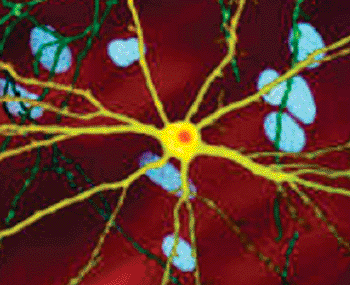Blood Test Aids Huntington's Disease Therapy
By LabMedica International staff writers
Posted on 17 Sep 2013
An assay has been designed to measure normal and abnormal forms of the huntingtin protein, the mutated form of which causes Huntington's disease (HD). Posted on 17 Sep 2013
The blood test could measure and detect levels of the mutant protein and changes in the levels of the mutated protein might predict when symptoms will appear in individuals at risk for the devastating neurological disorder.

Image: A microscope image of a neuron with inclusion, stained orange, caused by Huntington's disease (Photo courtesy of Dr. Steven Finkbeiner).
Scientists at Massachusetts General Hospital (Boston, MA, USA) took blood samples from 342 participants, collected at 35 centers around the USA, and analyzed their white blood cells. The levels of mutant huntingtin (mtHtt) and total huntingtin (tHtt) in blood leukocytes were analyzed with the homogeneous time-resolved fluorescence (HTRF) assay to assess its potential as a biomarker.
The investigators determined that 228 participants had 36 or fewer cytosine-adenine-guanine (CAG) repeats, repetitions of a particular nucleotide sequence within the huntingtin gene, indicating the normal form of the gene. The other 114, including 26 who had developed symptoms had 37 or more repeats, reflecting the HD mutation. Among participants with expanded CAG repeats, the HTRF assay signal for mutant huntingtin was significantly stronger than among those with normal CAG repeats. In participants with CAG expansion, analyzing HTRF results in relation to either the estimated time to symptom onset or the time when symptoms appeared suggested that assay results might change with the appearance of symptoms. Analysis of relationships to predicted time to onset or to phenoconversion suggested that the HTRF signal could mark changes during the Huntington disease prodrome or after clinical onset.
The authors concluded that The HTRF assay can effectively measure mtHtt in multicenter sample sets and maybe useful in trials of therapies targeting huntingtin. Miriam Moscovitch-Lopatin, PhD, the lead author said, "The extensive and consistent quality controls at the clinical sites, as well as those applied by our team in processing blood samples and performing the HTRF assay, were essential for the success of this study and will be vital for the future use of the assay." The study was published on August 21, 2013, in the journal Neurology.
Related Links:
Massachusetts General Hospital








 (3) (1).png)




